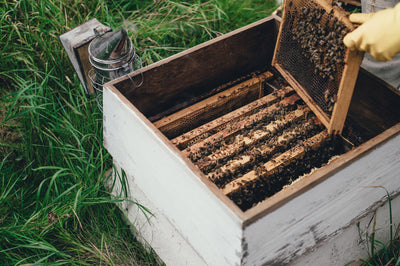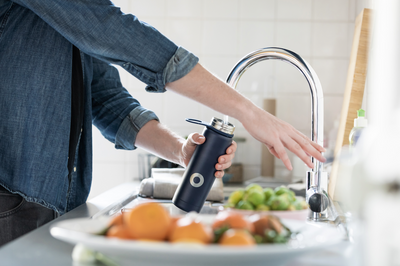Filtering out fluoride: A guide

In our last article, we revealed the UK government’s plans to order water fluoridation across the country – and explored the implications this could have on our health. Now, we’re offering up some solutions.
From the best at-home water filters to fluoride-free dental care, read on for simple ways to remove fluoride from your water and reduce your overall intake.
Invest in a tailored, researched water filtration system
If the government adds fluoride to the entire UK water supply, anyone who doesn’t want to ingest it will need to invest in an effective filtration system.
The best way to remove fluoride from drinking water? With a reverse osmosis water filter, a gravity fed water filter or a water distiller.
How they work:
Sometimes referred to as RO, reverse osmosis removes impurities by using pressure to force water through a semipermeable membrane of tiny pores that allow only water molecules through, keeping contaminants out. Reverse osmosis filters remove impurities without the use of chemicals, resins or ion exchange beds.
Gravity filters offer a simple yet effective way to purify water. They don’t need installation or power to work, are low maintenance and usually sit on the countertop. As you pour water into the top section, the force of gravity pushes it through the filters, leaving clean water in the lower chamber.
Water distillers offer another option for filtering your drinking water at home. Relatively inexpensive to buy and maintain, distillers produce contaminant-free water by heating it, converting it to vapour and then capturing the steam in a stainless steel coil where it cools to form pure, clean water.
What they remove:
Fluoride! But also, depending on the make, typically chlorine, lead, bacteria, E-coli, sediments, nitrates, hormones and pharmaceuticals too.
Considerations:
Filters and membranes need to be replaced according to the manufacturer’s instructions to keep water pure.
Keep in mind that reverse osmosis filters may also remove some minerals, like calcium and magnesium – although some (like the Osmio systems which we sell, see below) contain active ceramic mineral balls which work to remineralise the water for you.
Gravity water filters offer the added benefit of being environmentally friendly – wasting no water, needing no power and usually less frequent replacement of filters.
Water distillers don't tend to yield much water, taking up a fair bit of countertop in comparison to the liquid they produce. They can also be fairly slow to filter. We would also recommend re-energising the water and adding minerals after filtration with a distiller.
After filtering your water, to fully realign and energise it, you can use the Water Egg and Vortex Energiser.
Our pick of the best:
Osmio Zero Reverse Osmosis System

Smart and highly efficient, this is both a reverse osmosis water filter and a kettle that produces pure water with no installation and super easy user maintenance. Compact and portable, this countertop model offers ambient, hot, and boiling hot water at the touch of a button – and water which is thousands of times purer than traditional gravity filters or jug filters. It also uses flow monitoring to detect filter life, and wastes just 1 litre for every 5 litres of water, making it the most efficient RO in the world.
Shop it here
Osmio Fusion Reverse Osmosis System

This is the installed version of the countertop Osmio Zero (see above) – ideal for larger families (5+) and areas with hard water.
Shop it here
Osmio Clarity Gravity Water Filter System

The Osmio Clarity uses the best performing gravity water filter elements on the market: Coldstream Sentry filters. The Coldstream filters are extremely powerful, removing impurities with ease. They’re even able to reduce fluoride by up to 97% (other gravity fed systems require additional filters to remove fluoride).
We also love the fact this filter is made from glass rather than metal or plastic (which can leach chemicals and microplastics into your water). The natural, mango wood stand and lid make it a beautiful addition to your interior. It is ideal for households of up to 4 people.
Shop it here
Osmio Countertop Home Water Distiller

This 4L domestic countertop home water distillation system comes with an outer polished stainless steel body and a glass container for distilled water collection.
Shop it here
Whole house systems

These work to filter out fluoride and other contaminants from your home’s entire water supply, so that when you turn on the tap, you can be sure you’re getting safe, pure, clean water. If you want to avoid washing in fluoridated water (and therefore remove the risk of absorbing it through your skin or through steam inhalation), a whole house system is the way to go. Then, to be 100% sure you’ve taken the fluoride removal level up to 99%, you can also use a countertop gravity fed system for your drinking water.
We love the Osmio HT+ Home & Office Direct Flow Reverse Osmosis System. Clean and modern, its leading technology Direct Flow (no tank) reverse osmosis system ensures you get highly purified water on demand, with much easier maintenance. Plus, it sits out of site under your counter or sink, freeing up space at home.
Shop it here

How to reduce your overall fluoride intake
- Assume water is fluoridated unless you know for sure it isn’t. If you’re in an area with fluoridated water, don’t drink unfiltered tap water.
- At dental check-ups, don’t get fluoride-containing fissure sealants or fluoride drops. Always ask the dentist what materials they are planning to use on your own, and your children’s, teeth.
- Use fluoride-free toothpaste – especially for your kids. Some natural, non-fluoride toothpastes we like include those made by the Pristine Protocol, Living Libations, Dr Hisham’s – or mixing our own (stay tuned for the recipe in a future article!).
- If you use fluoridated toothpaste, rinse your mouth out thoroughly with water after brushing and only use a minimal amount of paste.
- Read the labels of your supplements, vitamins and medication. Avoid any that list fluoride as an ingredient.
- Choose your drinks carefully if you really want to cut back on fluoride. Black tea, green tea and Rooibos tea all contain naturally occurring fluoride (but they’re also rich in antioxidants, so weigh up what’s right for you). Reconstituted fruit juice, beer and fizzy drinks can also be made with fluoridated water.
- Swap non-stick pans for stainless steel and cast iron alternatives. Teflon is a fluorine compound that can off-gas when overheated.
- Avoid processed foods that can contain traces of fluoride.
- Some pesticides can leave fluoride residues on produce, so opt for organic when shopping for fruit and veg.
Things that WON’T remove fluoride from water:
- Most standard (and usually inexpensive) water filters. Activated-carbon water pitchers – like the Brita jugs people keep in their fridge – and tap attachments can’t remove fluoride.
- Boiling your water. Unlike chlorine, fluoride doesn’t evaporate easily. Boiling will only work to concentrate the fluoride in the remaining water.
A note on graphene oxide…
Plans are afoot to filter water with graphene oxide.
“Our scalable process applies a coating of graphene oxide – a form of graphene, the world’s strongest material – to existing polymer based water filtration membranes,” explains UK business G2O Water Technologies, which won its first commercial contract this summer.
The company says that graphene oxide enhances filter membrane performance, mitigating the effects of fouling, improving operational efficiency and reducing energy consumption and costs.
Using this technology, G2O has announced it is working “with a number of industry and innovation partners to scale up the technology and bring it to the market, ultimately delivering this new and unique filtration capability to a wide range of global companies”. From waste water treatment to domestic water filtration, it seems graphene oxide will soon be rolled out much more widely.
But, while some see graphene oxide as a useful addition to water cleaning, others are concerned at the prospect – and with legitimate reasons.
Research reveals that “currently, the literature is insufficient to draw conclusions about the potential hazards of graphene-family nanoparticles (GFNs).” Many experiments have shown that “GFNs have toxic side effects in many biological applications,” from lung to liver function, with “studies of brain injury or neurotoxicity” deserving “more attention in the future.” Then there’s the fact that graphene is highly conductive, leading to worries around electromagnetic radiation.
We asked the two companies we use whether their systems filter out graphene oxide. Their answer? The reverse osmosis water filtration system is the only type on the market that seems to be capable of removing it.
Main takeaways...
- For filtering out fluoride, opt for either the gravity fed or reverse osmosis filtration systems.
- To remove both fluoride and graphene oxide, try the reverse osmosis systems.
- You can find our countertop and undercounter water filters here. If you would like more information on the whole-house or the under the counter systems please contact us.
















































